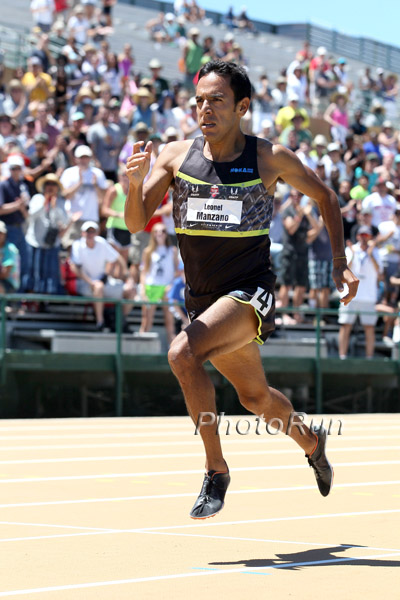Friday: Warm up; 5 miles easy running (400 Mile: 4 miles/300 Mile: 3 miles); cool down.
RelatedPosts
Magdelena Boulet, photo by PhotoRun.net
Weeks 1&2: Summer Training Begins
You’ll start on the road to a good summer of training with a long run, a tempo run, and some moderately paced runs. Don’t worry about pace in these first two weeks; just get out there, have some fun, and get into the habit of regular running. Workouts always begin with a warmup, some gentle stretching of major muscle groups, and light jogging. Repeat for your cool-down.
Monday: Warm up; 5 miles easy running (400 Mile: 4 miles/300 Mile: 3 miles); cool down.
Tuesday: 1-mile warmup; 20-min tempo run; 1-mile cool-down. To determine your tempo run pace, add a half-minute to your present mile pace for a 5K. For example: If you currently run 19 min for a 5K, that’s 6:10 pace. Add 30 seconds to get your tempo run pace of 6:40 per mile. Recalculate your pace as your fitness improves, about once a month.
Wednesday: Warm up; 5 miles easy running (400 Mile: 3 miles/300 Mile: 3 miles); cool down.
Thursday: 1-mile warmup; 2 hill repeats (run 200 yds uphill, turn, jog downhill to start; repeat once with no rest); 1-mile easy cool-down.
Friday: Warm up; 5 miles easy running (400 Mile: 4 miles/300 Mile: 3 miles); cool down.
Saturday: No workout. Walk, bike, watch a movie.
Sunday: Easy 6-mile run on grass or dirt with friends. (400 Mile: 5 miles/300 Mile: 5 miles)
Weeks 1&2 Totals per week (total): 500 Mile-31 (62) miles; 400 Mile-24 (48) miles; 300 Mile-22 (44) miles
Leo Manzano, photo by PhotoRun.net
Great Summer Training = Great Fall Racing
Summer training is vital to success, not only in cross country this fall, but also for the following spring track season. The key is to build yourself up, both physically and mentally. To help you crush your goals this year, American Track & Field and RunBlogRun have created a 500-mile summer training program. There are also 400- and 300-mile options for younger and less experienced athletes.
Before You Begin:
1. Get your gear in order.
If possible, you should have two pairs of good training shoes so you can rotate them. Most training shoes last for 8-10 weeks, depending on your training. Take your time at your local running store when selecting shoes and remember to go at the end of the day as your feet swell during the day. Bring a clean pair of socks and be prepared to check out 5-7 different shoes to find the right one for you. Assess your stash of socks, shorts, tops.
2. Hydrate yourself.
Eight to 10 glasses of water a day plus sports drinks and juice are a good start. Minimize the amount of coffee, tea, and carbonated soda you drink.
3. Fuel your engine with the right food.
Get the proper amounts and types of
food into your system. Fruits, vegetables, whole grains, pasta, and modest amounts of fish, chicken, and beef make sense. For snacks, try apple slices spread with peanut butter. Nuts are also good. Pizza, tacos, and fast food places are fine as infrequent treats.
4. Sleep!
I know that at 17 or 18 you can text all night or check out the newest game on Xbox, but it will affect your training. Get 8-10 hours of sleep and, if you can, try for a nap (yes, a nap) on a few afternoons.
5. Establish your training group.
Though some people prefer to train alone, a group helps with the hard days and long runs. Figure out what works for you and your training style.
6. Inspiration.
Find some good books that support your running goals. Some classics include Once a Runner, The Irishman Who Ran for Britain, The Lonely Breed, A Cold, Clear Day, and Self-Made Olympian. Music can also be a great motivator. Find great additions to your playlist by talking to your friends and searching online, plus we’ll post the Shoe Addicts’ running music lists. We don’t recommend running with earbuds or headphones, however, since they compromise your awareness and possibly your safety. They can also mess with your ability to “tune into” the pace you’re running, which is essential come race time. We just saw McFarland USA, a really nice cross country movie!
7. Set your goals.
Do you want to make the top 7? Improve your times at your league and section meets? Race better over the second half of the course? Think about these things now, write them down and prop them in your room where you can read them each day. It will help you stay on track.
8. Calculate your workout amounts.
To run 300 miles over 12 weeks, for example, you’ll need to average 25 miles a week, which is very good for freshmen and sophomores. To reach 400 miles over the summer, you need to average 34 miles a week, and to reach 500 miles, it takes a weekly average of 40 miles. The default numbers noted in the daily workouts (miles, reps, minutes) are for those accepting the 500 Mile Challenge. Numbers for those in the 400 Mile and 300 Mile Challenges appear in parentheses that follow. If there’s only one number/amount, it’s for all runners.
9. Questions?
Email us at runblogrun@gmail.com or tweet us @runblogrun and we’ll get back to you within 24 hours.
Author

Larry Eder has had a 52-year involvement in the sport of athletics. Larry has experienced the sport as an athlete, coach, magazine publisher, and now, journalist and blogger. His first article, on Don Bowden, America's first sub-4 minute miler, was published in RW in 1983. Larry has published several magazines on athletics, from American Athletics to the U.S. version of Spikes magazine. He currently manages the content and marketing development of the RunningNetwork, The Shoe Addicts, and RunBlogRun. Of RunBlogRun, his daily pilgrimage with the sport, Larry says: "I have to admit, I love traveling to far away meets, writing about the sport I love, and the athletes I respect, for my readers at runblogrun.com, the most of anything I have ever done, except, maybe running itself." Also does some updates for BBC Sports at key events, which he truly enjoys. Theme song: Greg Allman, " I'm no Angel."
View all posts























